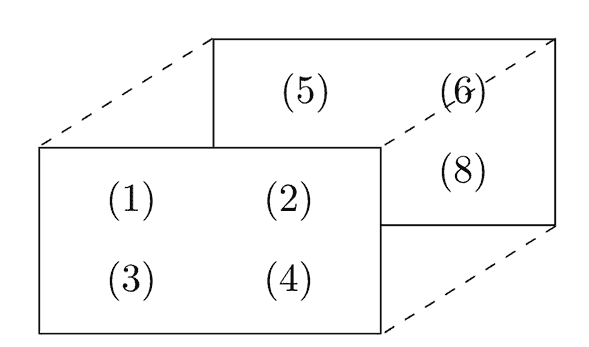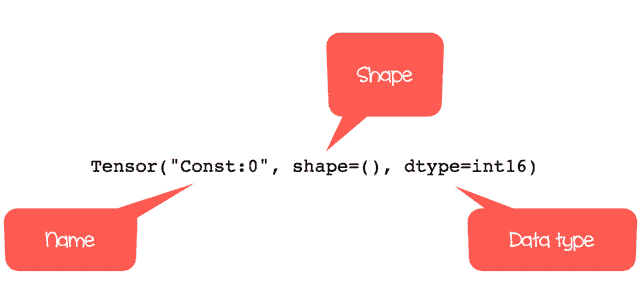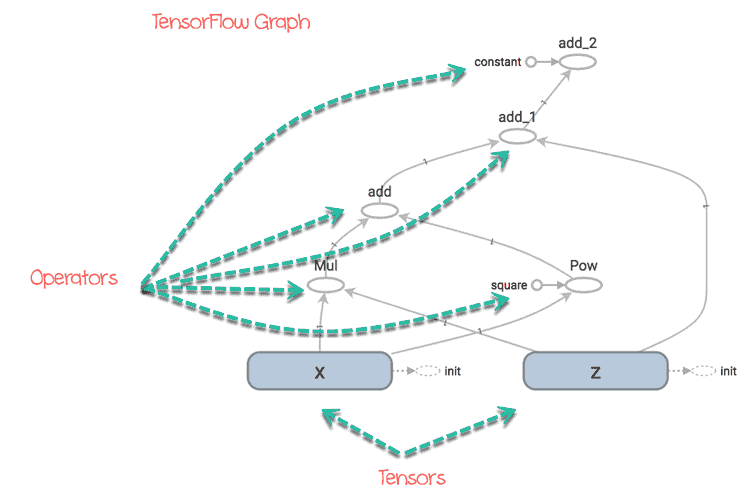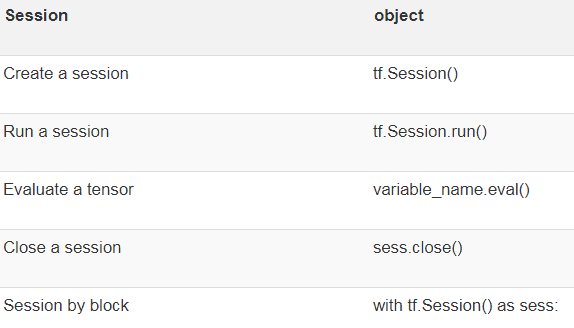

在机器学习中,模型被提供称为特征向量的对象列表。特征向量可以是任何数据类型。特征向量通常是填充张量的主要输入。这些值将通过张量流入op节点,此操作/计算的结果将创立一个新的张量,该张量又将用于新的操作。所有这些操作都可以在图表中查看。
在TensorFlow中,张量是n维的特征向量(即阵列)的集合。例如,2x3矩阵,其值为1到6
 图片.png
图片.pngTensorFlow将此矩阵表示为:
[[1,2,3], [4,5,6]]假如我们创立一个值为1到8的三维矩阵
 图片.png
图片.pngTensorFlow将此矩阵表示为:
[[[1,2], [[3,4], [[5,6], [[7,8]]注意:张量可以用标量表示,也可以有三维以上的形状。可视化更高维度级别更加复杂。
张量具备三个属性的对象:name、shape、dtype
TensorFlow执行的每个操作都涉及张量的操作。您可以创立四个主要张量:tf.Variable,tf.constant,tf.placeholder,tf.SparseTensor
tf.constant的使用说明:
tf.constant(value, dtype, name = "")arguments- `value`: Value of n dimension to define the tensor. Optional- `dtype`: Define the type of data: - `tf.string`: String variable - `tf.float32`: Flot variable - `tf.int16`: Integer variable- "name": Name of the tensor. Optional. By default, `Const_1:0` 0维,即标量:
>>> r1 = tf.constant(1, tf.int16)>>> r1<tf.Tensor 'Const:0' shape=() dtype=int16> 图片.png
图片.png可以给标量取个名字:
>>> r2 = tf.constant(1, tf.int16, name = "my_scalar")>>> r2<tf.Tensor 'my_scalar:0' shape=() dtype=int16>>>> r1_decimal = tf.constant(1.12345, tf.float32)>>> r1_decimal<tf.Tensor 'Const_1:0' shape=() dtype=float32>>>> r1_string = tf.constant("https://china-testing.github.io", tf.string)>>> r1_string<tf.Tensor 'Const_2:0' shape=() dtype=string>维度:
>>> r1_vector = tf.constant([1,3,5], tf.int16)>>> r1_vector<tf.Tensor 'Const_3:0' shape=(3,) dtype=int16>>>> r2_boolean = tf.constant([True, True, False], tf.bool)>>> r2_boolean<tf.Tensor 'Const_4:0' shape=(3,) dtype=bool>>>> r2_matrix = tf.constant([ [1, 2], [3, 4] ],tf.int16)>>> r2_matrix<tf.Tensor 'Const_5:0' shape=(2, 2) dtype=int16>>>> r3_matrix = tf.constant([ [[1, 2], [3, 4], [5, 6]] ], tf.int16)>>> r3_matrix<tf.Tensor 'Const_6:0' shape=(1, 3, 2) dtype=int16>>>> m_shape = tf.constant([ [10, 11], [12, 13], [14, 15] ] )>>> m_shape.shapeTensorShape([Dimension(3), Dimension(2)])>>> tf.zeros(10)<tf.Tensor 'zeros:0' shape=(10,) dtype=float32>>>> tf.ones([10, 10])<tf.Tensor 'ones:0' shape=(10, 10) dtype=float32>>>> tf.ones(m_shape.shape[0])<tf.Tensor 'ones_2:0' shape=(3,) dtype=float32>>>> tf.ones(m_shape.shape[1])<tf.Tensor 'ones_4:0' shape=(2,) dtype=float32>>>> tf.ones(m_shape.shape)<tf.Tensor 'ones_5:0' shape=(3, 2) dtype=float32>>>> m_shape.dtypetf.int32>>> type_float = tf.constant(3.123456789, tf.float32)>>> type_int = tf.cast(type_float, dtype=tf.int32)>>> type_float.dtypetf.float32>>> type_int.dtypetf.int32>> tensor_a = tf.constant([[1,2]], dtype = tf.int32)>>> tensor_b = tf.constant([[3, 4]], dtype = tf.int32)>>> tensor_add = tf.add(tensor_a, tensor_b)>>> tensor_add<tf.Tensor 'Add:0' shape=(1, 2) dtype=int32>>>> tensor_multiply = tf.multiply(tensor_a, tensor_b)>>> tensor_multiply<tf.Tensor 'Mul:0' shape=(1, 2) dtype=int32>tf.get_variable(name = "", values, dtype, initializer)argument- `name = ""`: Name of the variable- `values`: Dimension of the tensor- `dtype`: Type of data. Optional- `initializer`: How to initialize the tensor. OptionalIf initializer is specified, there is no need to include the `values` as the shape of `initializer` is used.>>> var = tf.get_variable("var", [1, 2])>>> var.shapeTensorShape([Dimension(1), Dimension(2)])>>> var_init_1 = tf.get_variable("var_init_1", [1, 2], dtype=tf.int32, initializer=tf.zeros_initializer)>>> var_init_1.shapeTensorShape([Dimension(1), Dimension(2)])>>> tensor_const = tf.constant([[10, 20], [30, 40]])>>> var_init_2 = tf.get_variable("var_init_2", dtype=tf.int32, initializer=tensor_const)>>> print(var_init_2.shape)(2, 2) 图片.png
图片.pngtf.placeholder(dtype,shape=None,name=None )arguments:- `dtype`: Type of data- `shape`: dimension of the placeholder. Optional. By default, shape of the data- `name`: Name of the placeholder. Optional >>> data_placeholder_a = tf.placeholder(tf.float32, name = "data_placeholder_a")>>> print(data_placeholder_a)Tensor("data_placeholder_a:0", dtype=float32)Graph
TensorFlow的基础。 所有数学运算(ops)都在Graph中执行。 您可以将Graph想象为每个操作都已完成的项目。 节点代表这些操作,它们可以吸收或者创立新的张量。
Tensor
张量表示在操作之间进行的数据。 您之前看到过如何初始化张量。 常量和变量之间的差异是变量的初始值将随时间变化。
会话将从图中执行操作。 要使用张量值来提供图形,您需要打开会话。 在会话内,运行操作以创立输出。
>>> x = tf.constant([2])>>> y = tf.constant([4])>>> multiply = tf.multiply(x, y)>>> sess = tf.Session()2018-11-21 22:41:34.184786: I tensorflow/core/platform/cpu_feature_guard.cc:141] Your CPU supports instructions that this TensorFlow binary was not compiled to use: AVX2 FMA>>> result_1 = sess.run(multiply)>>> print(result_1)[8]>>> sess.close()>>> with tf.Session() as sess:... result_2 = multiply.eval()... print(result_2)...[8]>>> sess = tf.Session()>>> print(sess.run(r1))1>>> print(sess.run(r2_matrix))[[1 2] [3 4]]>>> print(sess.run(r3_matrix))[[[1 2] [3 4] [5 6]]]>>> sess.run(tf.global_variables_initializer())>>> print(sess.run(var))[[ 0.5487809 -0.9846178]]>>> print(sess.run(var_init_1))[[0 0]]>>> print(sess.run(var_init_2))[[10 20] [30 40]]>>> import numpy as np>>> power_a = tf.pow(data_placeholder_a, 2)>>> with tf.Session() as sess:... data = np.random.rand(1, 10)... print(sess.run(power_a, feed_dict={data_placeholder_a: data})) # Will succeed....[[0.00214566 0.22329086 0.03267581 0.97980934 0.10616333 0.08555447 0.06780323 0.23336452 0.10076617 0.01539159]] 图片.png
图片.png 图片.png
图片.pngx = tf.get_variable("x", dtype=tf.int32, initializer=tf.constant([5]))z = tf.get_variable("z", dtype=tf.int32, initializer=tf.constant([6]))c = tf.constant([5], name = "constant")square = tf.constant([2], name = "square")f = tf.multiply(x, z) + tf.pow(x, square) + z + cinit = tf.global_variables_initializer() # prepare to initialize all variableswith tf.Session() as sess: init.run() # Initialize x and y function_result = f.eval() print(function_result)执行结果: [66]
 图片.png
图片.png